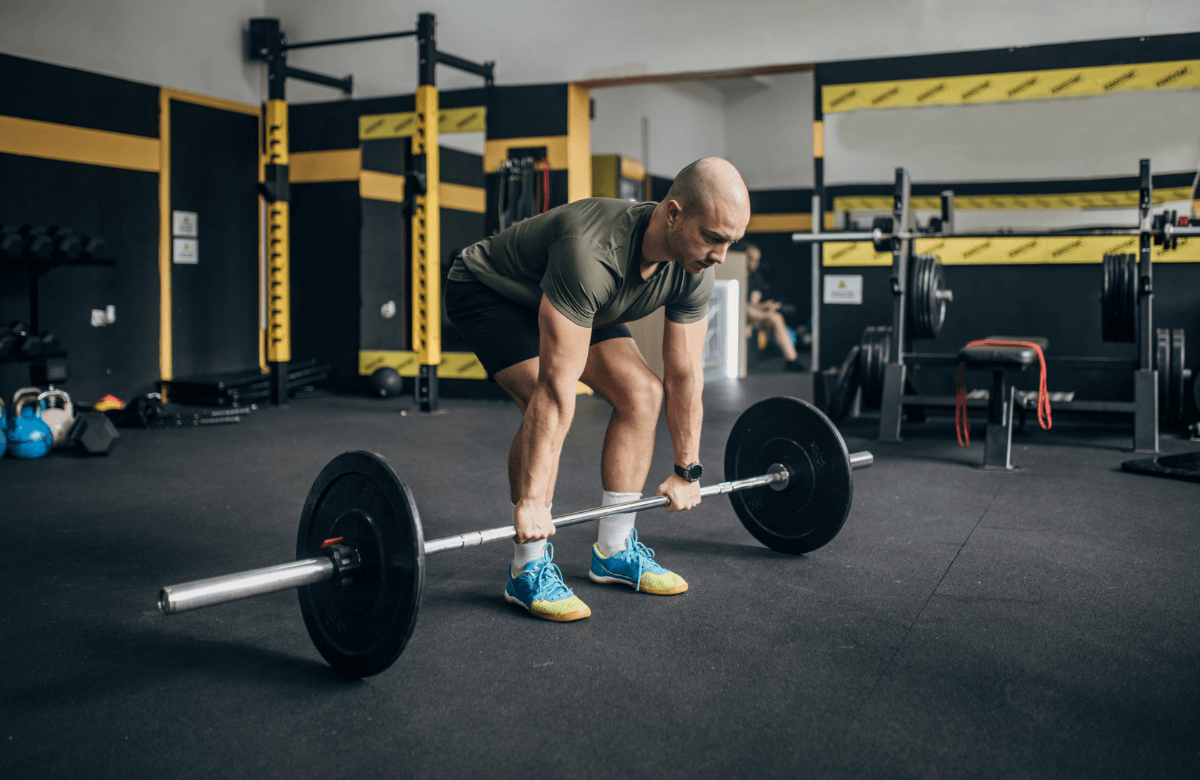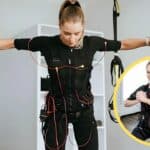Unlock the secret to sculpting your dream legs as we delve into the world of resistance training with a spotlight on Stiff-Leg Deadlift vs. RDL. What’s the difference? When should you implement these into your workout routine? Let’s discover which of these powerhouse exercises will take your fitness journey to the next level.
Jump to:
- What Is a Romanian Deadlift?
- What Is a Stiff Leg Deadlift?
- How to Perform The Romanian Deadlift
- How to Perform The Stiff Leg Deadlift
- Stiff Leg Deadlift Vs RDL: The 10 Top Differences
- Stiff Leg Deadlift Vs RDL: Muscles Worked
- Stiff Leg Deadlift Vs RDL: Benefits
- Who Should Use a Stiff Leg Deadlift ?
- Who Should Use a Romanian Deadlift ?
- Stiff Leg Deadlift Vs RDL: FAQs
What Is a Romanian Deadlift?
The Romanian deadlift was invented by a Romanian weightlifter named Nicu Vlad for the Goodwill Games in 1990. He wanted to work on hamstring and lower back strength and build power for pulling movements.
The RDL is a very posterior-focused exercise meaning that it targets the musculature of the back side because we are focusing more on the eccentric lengthening movement pattern for a lot of the muscles in the back side, including glutes and hamstrings.
What Is a Stiff Leg Deadlift?
The stiff leg deadlift, also called the straight leg deadlift, is pretty self-explanatory. It’s a deadlift performed with stiff legs. It’s a different way of targeting your lower back and leg muscles.
Let’s cover the nuances of each movement.
How to Perform The Romanian Deadlift
The Romanian deadlift can start from one of two positions. You can just pick the weight up off the floor like a normal deadlift or you can take it out of the squat rack.
You are going to take the same stance width and toe angle as when you perform a traditional deadlift. While standing tall, hold your back and abs tight. Start the movement by pushing your hips back and letting the barbell slide down your thighs. Continue reaching down to about the middle shin. Without pausing at the bottom, stand back up by dragging the barbell up your legs.
If you feel your back starting to excessively round over as you reach the bottom, you might be reaching a little bit too far. In this case, we would suggest moving the turn-around point higher like just below the knees. Or you might just be doing a poor job of holding your back tight from the start.
How to Perform The Stiff Leg Deadlift
For the stiff leg deadlift, your legs do not need to be completely straight. Your hips should be higher than a conventional deadlift starting position. Your shins should be more vertical and the bar should not be touching your shins at the start.
Take your grip right outside of your legs. Without dropping your hips and without bringing your shins forward, squeeze your chest out, flatten your back, and pull.
The straight leg deadlift puts you at a mechanical disadvantage. Your legs are straighter and the angle of your knee is greater. Therefore, you can’t use as much leg drive as you can with a regular deadlift. This is why most people do the stiff leg deadlift with less weight than they do the traditional deadlift.
What is the point of putting yourself at a mechanical disadvantage? It’s the same reason you might do a pause squat. Changing leverages, limiting speed, and removing the stretch reflex are all ways of putting yourself at a disadvantage.

Stiff Leg Deadlift Vs RDL: The 10 Top Differences
For many people, the major differences between a Romanian deadlift and a stiff-legged deadlift are not overly clear. Let’s make it clear.
1. The Starting Position
The main difference between these two deadlift movements is the starting position. The stiff-leg deadlift starts and ends on the floor just like a standard deadlift. The weight is picked up from a dead stop.
The Romanian deadlift starts at the top or the lockout position. The weight never actually touches the ground until you’re finished with the set.
2. Position of The Knees
When talking about technique, one of the most important pieces of the stiff leg deadlift and the Romanian deadlift is the position of the knees.
At the start of a normal conventional deadlift, the knees should be against the insides of the arms. The front of the knees should be flush with the front of the arms. If the knees are behind the arms, your hips are probably too high. If your knees are traveling in front of your arms, your hips are probably too low.
At the start of a stiff leg deadlift, the knees should be behind the arms. This puts your hips higher, shins closer to vertical, and leg straighter or stiffer when compared to a conventional deadlift.
For the Romanian deadlift exercise, the front of your knees should be flush with the front of your arms at the start. Just like the stiff leg deadlift, it’s important to note that your knees are staying behind your arms at the bottom.
The bottom position of the Romanian deadlift looks exactly like a stiff leg deadlift – hips high, shoulders over the bar, shins vertical, and knees behind your arms.
3. Eccentric Portion
Another obvious difference between the stiff leg deadlift and the Romanian deadlift is the eccentric portion included in the Romanian deadlift and not included in the stiff leg deadlift. You have to experiment with the exercises to feel the difference.
The stiff leg deadlift is really just a pull from the floor and then it controlled drop from the top. The Romanian deadlift uses its eccentric or loading portion to create a stretch reflex at the bottom. You lengthen and then contract.
4. Flexion
The main issue here is going to be around knee flexion. Typically, what we’re going to see when we’re executing an RDL is there’s going to be much more knee flexion.
When we’re doing a stiff-legged deadlift, there’s going to be much more hip flexion with an almost extended knee joint. What that does is it targets the hamstrings and lower back a little bit more.
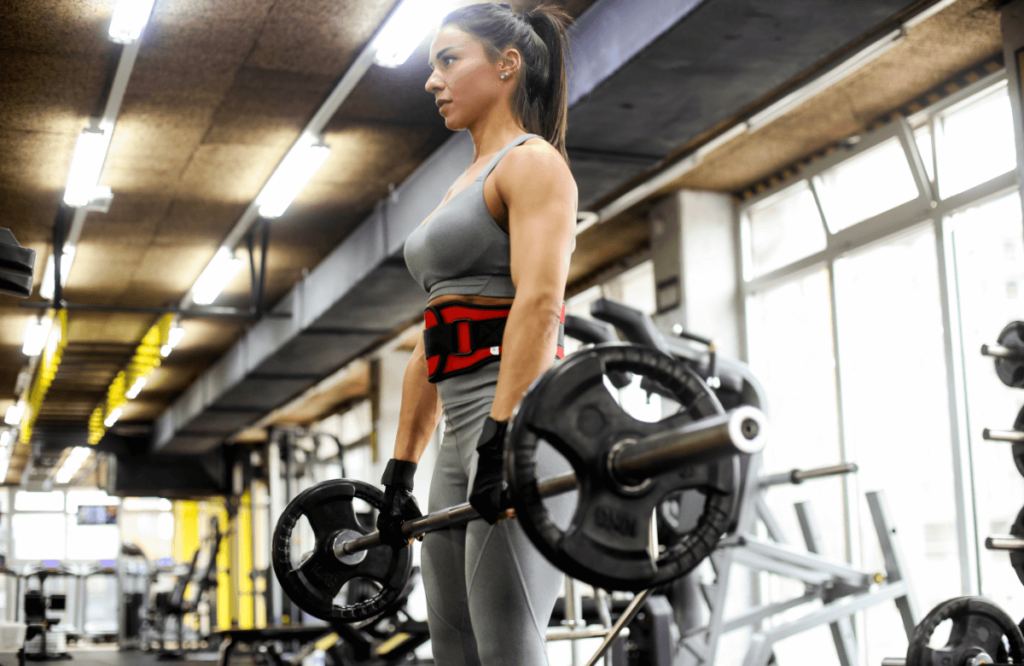
5. Time Under Tension
The biggest difference between a Romanian deadlift and a stiff leg deadlift is with the Romanian variation you’re not going to let the weight plates touch the floor in between repetitions. You want to keep constant tension on the muscles throughout the entire exercise. This builds a lot of time under tension and it’s good from a muscle-building hypertrophy point of view.
With a stiff leg deadlift, you’re taking the tension off the muscles temporarily in between each repetition. From a muscle hypertrophy point of view, you’re not getting that time under tension the same. You’re not getting the same pump and the same level of muscle activation as with a Romanian deadlift.
6. Focus
Another key difference is with a stiff leg deadlift, you’re focusing primarily on lifting the weight up. The main emphasis is getting the weight off the floor. And you pause the weight on the floor in between repetitions. This is good for building starting strength because you start from a dead stop each time which makes it a true deadlift. However, by doing that you temporarily give the muscles a break.
With the Romanian deadlift, you’re focusing primarily on the negative aspect and lowering the weight down. You want to lower the weight under control focusing on stretching out the hamstrings and glutes. As you do that, you let your pelvis drift backward.
So, when you’re executing the RDL, focus on a little bit more knee flexion. When you’re executing the stiff-legged deadlift, try to feel that long hamstring getting lengthened, and then extend the hips at the top.
7. Stress on The Lower Back Area
The stiff leg deadlift tends to place a bit more stress on the lower back area. So, if you have any lower back problems, you’d probably be better off doing a Romanian deadlift variation.
To practice the Romanian deadlift, you don’t even need to use any weight at all. You can just practice lowering yourself down, going through the negative, and feeling the hamstrings and glutes stretch.
8. Loading Pattern
The fundamental difference is how they’re going to be executed. The RDL is a top-down exercise that focuses more on the eccentric loading pattern and builds hinge strength. The stiff leg deadlift starts from the floor. It’s going to be a bit more concentric in nature because we’re picking that weight off of the floor.
For an RDL, you’re almost going to sit the hips back and then have a little bit more knee flexion. It entails a shorter range of motion. To perform a stiff-legged deadlift, you are going to bring your chest forward more lengthening the hamstrings and back up.
9. Intent
When it comes to the applicability of the RDL, this exercise is going to be a better bet for building your hip hinge strength and form. On the other hand, the stiff leg deadlift is a bit more specific for improving your deadlift strength and hip extension strength because there is a focus on strength off the floor.
Since we’re going to have a more stiff-leg position and less knee flexion, the barbell will usually be a bit further out from us compared to the normal conventional deadlift. That’s going to have us focus a bit more on maintaining a very strong hip angle. This can help us build strength off the floor when it comes to building up the hamstrings, glutes, and other muscles required for maintaining certain positions.
Understanding this fundamental difference of intent can help you implement these popular deadlift variations into your workout routine. In addition, it helps you decide which would probably be better based on your goals.
10. Volume
In general, the stiff leg deadlift is usually done with a little bit lower reps and heavier weight when compared to the Romanian deadlift. The weight of a Romanian deadlift is generally lighter than any other deadlift variation.
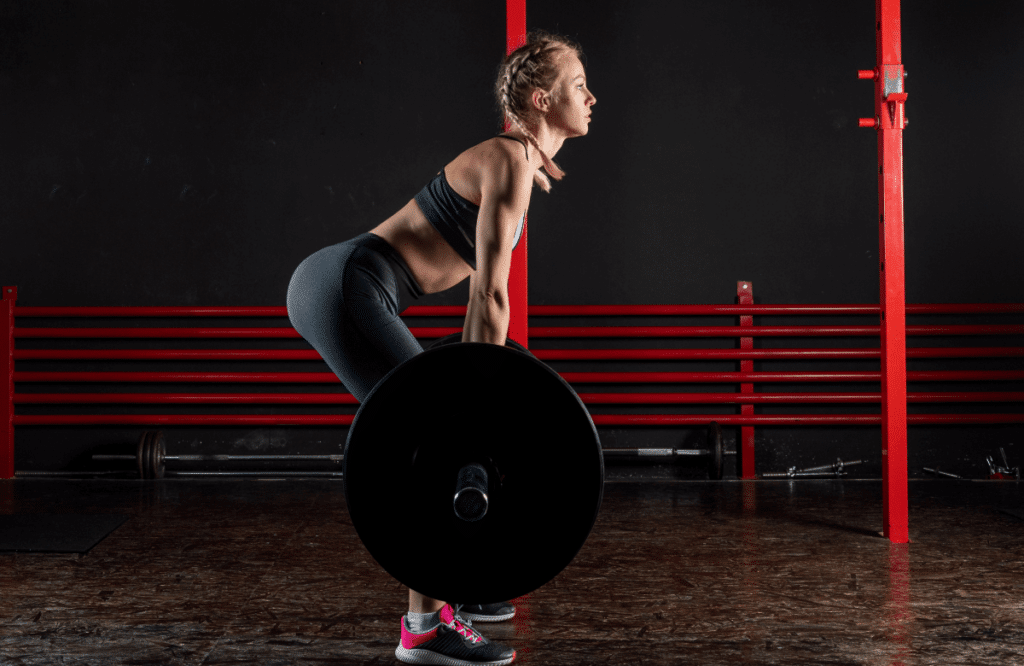
Stiff Leg Deadlift Vs RDL: Muscles Worked
When it comes to muscles worked for each of these exercises, we’re going to have primarily the posterior chain muscles involved: the hamstrings, glutes, calves, lats to some degree, spinal erectors, traps, and forearms. All these muscles will be our prime movers.
If we take it a step further, we can even direct our approach a bit more specific in nature.
RDL: Muscles Worked
With the RDL specifically, we are starting from a top-down position. We’re focusing on eccentric loading. So, a lot of our focus is going to be on the hip joint and moving around that hinge position. Therefore, the hamstrings and glutes are going to be fired up the most in the RDL variation.
Stiff Leg Deadlift: Muscles Worked
SLDL is an exercise designed mostly to hit the hamstrings. But it engages the lower back more than the RDL.
The stiff leg deadlift starts from the floor. What would that indicate? We’re probably going to get a bit more work out of the back musculature because we are having that barbell be further away from the body to start. In addition, we’re going to have to maintain our torso’s positioning and make sure we’re not going into excessive flexion as soon as we start to lift that bar.
With the stiff leg deadlift, we’re going to have the lats, traps, and erectors serving as stabilizers in this movement a bit more compared to the RDL. We’re not starting from the top and only focusing on the hinge. We are focusing a bit more on the concentric movement pattern with the barbell that’s further from our center of mass.
Stiff Leg Deadlift Vs RDL: Benefits
Both exercises are fantastic and can lead to improvements in weight-lifting exercises such as traditional deadlifts. However, both of them do have their place specific to the technique being executed.
Pros of The Stiff Leg Deadlift
1. Specificity For Breaking The Floor
It could be a useful tool for teaching control off the floor and focusing on body strength when breaking the floor.
Once you are a bit more in tune with understanding how to deadlift, the stiff leg deadlift is a decent variation to play around with when it comes to focusing on breaking the floor because we’re starting with that barbell further away from our center of mass.
2. Targeting The Lower Back Muscles More
The stiff leg deadlift is better for targeting some of the back musculatures because we need to create stability at the torso when breaking the floor in the concentric movement pattern of a deadlift.
Pros of The Romanian Deadlift
1. Applicability
The RDL offers wider applicability to multiple other movements. It’s a bit more friendly for athletes who want to improve their hinge strength or posterior chain strength for their sport. The RDL has way more applicability for a wider range of sports and needs.
It’s a bit easier to plug in the RDL in workout programs and make it work with your goals. In addition, you can make it a primary exercise when focusing on posterior strength. This makes it an invaluable tool for a lot of different things.
So, when it comes to programming, the RDL is a better option for focusing on posterior strength specifically and building your hinge strength and mechanics.
2. Beginner Friendly
The Romanian deadlift is a great exercise for teaching the fundamentals of the hip hinge. There are a lot of different variations of this movement that you can do. For example, you can perform landmine or dumbbell variations.
3. It Can Be Progressed in Multiple Ways
On top of being beginner-friendly, you can do single-leg RDLs. You can add pauses or tempos. There are so many other ways you can make RDLs tough. It opens up a lot of different avenues for training the posterior muscles. It’s easy to find variations that work for nearly every lifter.
4. Building Posterior Muscles
The RDL is usually a better option for focusing on posterior hypotrophy and strength because we’re trying to focus on eccentric loading patterns.
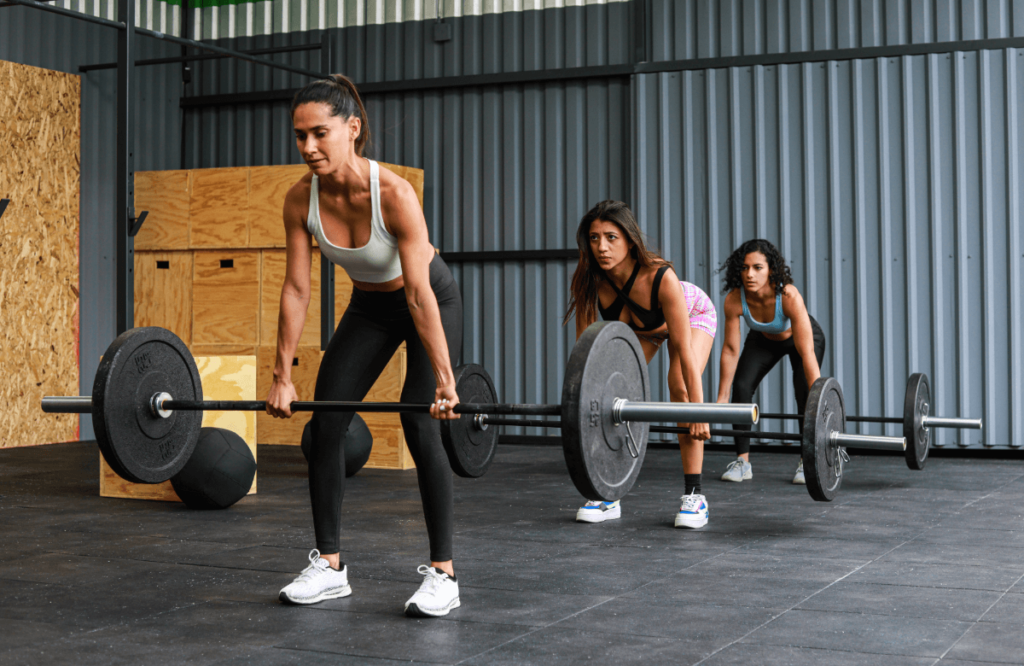
Who Should Use a Stiff Leg Deadlift ?
1. For Somebody Who Builds Explosiveness
The stiff leg deadlift is better from a strength point of view. You’re building that starting strength and that explosiveness from having to start the exercise from a dead stop with each repetition. So, the stiff leg deadlift is for somebody who is focusing on strength off the floor.
If you notice that you’re not that strong off the floor, then the stiff leg deadlift can be a useful tool. If you notice any discrepancies in your starting position when doing conventional deadlifts, these can be a useful tool to focus on any of those specific skills. So, when your goal is building strength off the floor, you’re just focusing on maintaining stronger hip and torso angles.
2. For Experienced Lifters
The stiff-leg deadlift is for lifters who are accustomed to deadlifting and understand how to perform deadlifts well.
We don’t recommend the stiff leg deadlift for beginners. If you have to still work on your fundamental movement patterns with the deadlift, there is no point in increasing your hip height and pushing the barbell away.
The stiff leg deadlift will not have as much applicability to other exercises like the RDL. It is a bit more specific for the deadlift especially when you are trying to focus on strength off the floor because you’re not starting in that stiff leg position in a lot of movements.
Who Should Use a Romanian Deadlift ?
From a bodybuilding point of view, the Romanian deadlift is better. There is some time under tension for building hypertrophy.
The Romanian deadlift is a good hamstring and glute exercise. It’s not so much a lower back exercise even though the lower back is going to come in as a stabilizer and supporting muscle. So, it’s not as back-dominant as a stiff leg deadlift or a traditional conventional deadlift.
If your main goal is to build up your hamstrings and glutes, use the Romanian deadlift. If you just want to add more pulling volume to your body workout program, implement Romanian deadlifts.
Stiff Leg Deadlift Vs RDL: FAQs
Is SLDL or RDL better for hamstrings?
The stiff leg deadlift and the Romanian deadlift are both great exercises for hamstring muscles that you can include into your routine.
Which Is Better SDL or RDL?
RDL is going to be a better more applicable approach to building the posterior muscles. The stiff leg deadlift is going to train the posterior chain too. However, it has a way more specific approach when it comes to training strength off the floor and focusing on deadlift starting mechanics.
What Muscles Do RDL vs. Stiff Leg Work?
With the stiff leg deadlift, we are going to be a bit more focused on the back musculature in addition to our prime movers the hamstrings and glutes.



